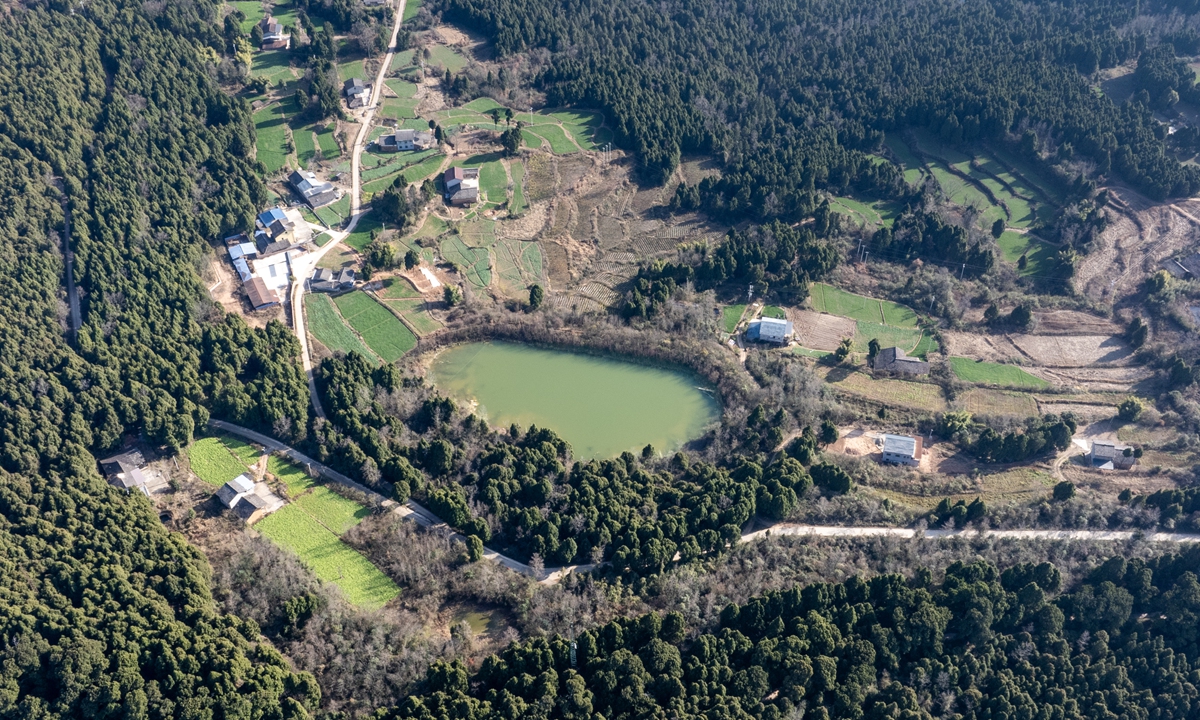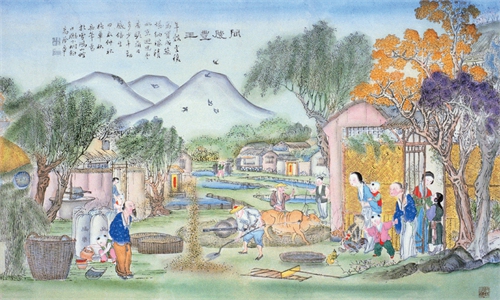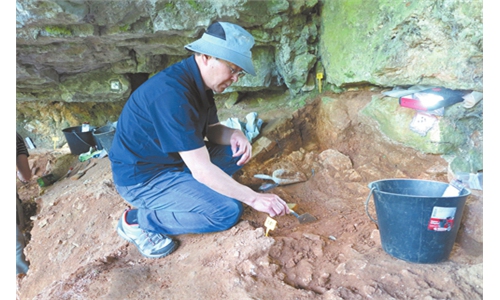ARTS / CULTURE & LEISURE
New discoveries illuminate the legacy of China's Shu Roads
Tracing ancient footsteps

Ancient cypress trees form a spectacular green corridor along the historic Shu Roads in Jiange county, Guangyuan city, Southwest China's Sichuan Province, on January 16, 2025. Photo: VCG
In the towering mountains and deep valleys of Shu Roads in Southwest China, a group of young archaeologists trek along thousand-year-old trails, uncovering traces of history hidden in dense forests and sheer cliffs.
The Ancient Shu Roads are a 2,300-year-old system spanning more than 1,000 kilometers that connect today's Xi'an, Northwest China's Shaanxi Province, and Chengdu, Southwest China's Sichuan Province, over the Qinling and Daba mountains. The part that is not within Sichuan is also included, as it is the way to Sichuan.
On Saturday, the latest milestones of the Shu Roads archaeological project were unveiled. To date, investigations have covered six main routes—Jinniu, Micang, Lizhi, Chencang, Baoxie, and Qishan roads—surveying a total of 2,073 kilometers and documenting 1,034 cultural relic sites, including 297 newly discovered locations, per the Xinhua News Agency.
As the first major project dedicated to a linear cultural heritage, the Shu Roads initiative has unified investigation standards and transcended administrative boundaries, forging a cross-regional, interdisciplinary model now referred to as the "Shu Roads Experience."
"In the past, we had some site-like relics, but nothing like the Shu Roads—ancient relics in the form of actual lines. This innovative approach offers new insights into the protection and understanding of ancient Chinese roads," Zheng Wanquan, associate researcher at the Sichuan Provincial Cultural Relics and Archaeology Research Institute, told the Global Times.
Familiar visitor with changing road
This spring, the news of the 83-year-old American woman, Hope Justman, returning to walk the Shu Roads spread quickly across Guangyuan's Jiange county in Sichuan.
The story began when this scholar paused before a painting at an exhibition at age 20—the Tang Dynasty masterpiece of Emperor Minghuang's Journey to Shu—captivated by the cliff-hugging plank roads depicted in the top left corner. "Did such roads really exist?" she remembered wondering, a question that would eventually shape her life's passion.
In 2025, standing again under the shade of ancient trees along the ancient trail, the same sense of awe washed over her as she began her 25th journey of the Shu Roads.
"I never expected that a road I had written off as lost in my earlier book actually still exists — and has now been cleared and restored," Justman told her Chinese companion Chen Yang, who brought her to the newly cleaned up roads she never expected to visit five years ago.
During her early visits, the ancient cypress trees lining the trails stood tall and resilient but were largely left without formal protection. Years later, each venerable tree was adorned with a plaque, with detailed information and guardians assigned for their care.

83-year-old American Hope Justman (right), walks the Shu Roads in Guangyuan city, Southwest China's Sichuan Province, on March 15, 2025. This is her 25th journey on the Shu Roads. Photo: Courtesy of Chen Yang.
Chen told the Global Times that he remembered for this time, that Justman brought several friends from the US and was surprised to find QR codes attached to the plaques, revealing a "digital ID card" for each tree, listing species, health status, approximate age, protection grade, and maintenance schedules.
In January, China introduced its first national-level regulations to protect ancient and notable trees, mandating stringent daily care obligations and explicitly prohibiting the felling of or unauthorized interference with heritage trees.
"Indeed, not only for the trees, but the Shu Roads project's progress mirrors a broader societal embrace of heritage preservation," Chen said.
Also around this time in 2024, the Shu Roads initiative of archaeology was officially launched, embarking on a journey to systematically recover, study, and conserve one of the oldest and most vital arteries of Chinese civilization.
Mapping a living heritage
The Shu Roads once served as lifelines connecting China's central plains with the lush Sichuan Basin, not only facilitating commerce but also military campaigns, administrative governance, and cultural exchange.
Since March 2024, archaeological institutions and universities across four regions have collaborated closely forming an unprecedented alliance dedicated to uncovering the secrets of these ancient trails.
"The effort has yielded the most accurate and comprehensive 'Shu Roads data' compiled yet, documenting well-preserved sections across the six principal routes," Zheng noted.
Archaeologists have unearthed a wealth of relics, including diverse forms of stone-paved side roads, treacherous plank roads clinging to cliffs, and intricate ancient bridges. Comparative studies across different sections have also highlighted remarkable regional adaptations, reflecting the ingenuity and resilience of Shu Roads builders in overcoming the region's challenging terrains.
Data reveals that the Jinniu Road preserves the finest examples of side road construction, the Micao Road features the richest diversity of bridges, and the Lizhi Road boasts the most newly identified sections.
Among the most thrilling discoveries is the dragon king moat along the Micao Road.
There, eight inscriptions from five successive dynasties vividly trace the road's unbroken importance from the Tang Dynasty (618-907) through the Qing Dynasty (1644-1911) period, offering direct evidence of the Shu Roads' role as arteries of connection, trade, and power.
Excavations have brought to light ruins of ancient cities, way stations, fortresses, and customs points. "These findings illustrate how the Shu Roads not only connected distant regions but also supported a sophisticated infrastructure essential to governance and imperial cohesion across five successive dynasties," Zheng recalled.
Beyond tangible findings, the project has pioneered methodological innovations for linear heritage archaeology.
For the first time, archaeologists defined a core 50-meter-wide corridor flanking the ancient routes for systematic relic documentation, adopting a "stringing points along lines" approach. They also standardized recording methods and road classification protocols, ensuring consistency across different teams and regions.
A comprehensive Shu Roads data platform is also expected to be built as a major step toward digital conservation and public accessibility, Zheng noted.
Liu Zhiyan, the deputy director of the institute, told the Global Times that this project is a bold attempt at refining theories and methods for surveying linear cultural heritage. "It offers valuable lessons for future multidisciplinary cooperation and sets an exemplary model for safeguarding ancient roads and linear relics nationwide."
Today, with every inscription unearthed and every ancient tree preserved, the Shu Roads continue to tell their story. "More and more foreign friends from different countries are coming to me to explore the Shu Roads. This is surely an ancient road and a cultural heritage that belongs to the world."




